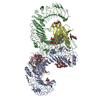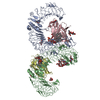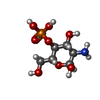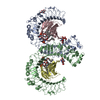+ Open data
Open data
- Basic information
Basic information
| Entry |  | |||||||||
|---|---|---|---|---|---|---|---|---|---|---|
| Title | Cryo-EM Structure of Mouse TLR4/MD-2/DLAM3 Complex | |||||||||
 Map data Map data | main map | |||||||||
 Sample Sample |
| |||||||||
 Keywords Keywords | Innate immune system / Toll-like receptors / TLR4 agonist / Vaccine adjuvants / Disaccharide-based Lipid A Mimetics / IMMUNE SYSTEM | |||||||||
| Function / homology |  Function and homology information Function and homology informationMyD88-independent TLR4 cascade / Caspase activation via Death Receptors in the presence of ligand / Toll Like Receptor 4 (TLR4) Cascade / Heme signaling / nitric oxide production involved in inflammatory response / Regulation of TLR by endogenous ligand / MHC class II biosynthetic process / TRIF-mediated programmed cell death / positive regulation of cellular response to macrophage colony-stimulating factor stimulus / TRAF6-mediated induction of TAK1 complex within TLR4 complex ...MyD88-independent TLR4 cascade / Caspase activation via Death Receptors in the presence of ligand / Toll Like Receptor 4 (TLR4) Cascade / Heme signaling / nitric oxide production involved in inflammatory response / Regulation of TLR by endogenous ligand / MHC class II biosynthetic process / TRIF-mediated programmed cell death / positive regulation of cellular response to macrophage colony-stimulating factor stimulus / TRAF6-mediated induction of TAK1 complex within TLR4 complex / IRAK2 mediated activation of TAK1 complex upon TLR7/8 or 9 stimulation / Regulation of TBK1, IKKε (IKBKE)-mediated activation of IRF3, IRF7 / Activation of IRF3, IRF7 mediated by TBK1, IKKε (IKBKE) / lipopolysaccharide immune receptor activity / positive regulation of nucleotide-binding oligomerization domain containing 1 signaling pathway / positive regulation of matrix metallopeptidase secretion / Toll-like receptor 4 binding / IKK complex recruitment mediated by RIP1 / mast cell activation / detection of lipopolysaccharide / positive regulation of lymphocyte proliferation / regulation of dendritic cell cytokine production / lipopolysaccharide receptor complex / negative regulation of interleukin-23 production / cellular response to oxidised low-density lipoprotein particle stimulus / wound healing involved in inflammatory response / lymphocyte proliferation / B cell proliferation involved in immune response / nucleotide-binding oligomerization domain containing 1 signaling pathway / positive regulation of nucleotide-binding oligomerization domain containing 2 signaling pathway / activation of NF-kappaB-inducing kinase activity / positive regulation of stress-activated MAPK cascade / intestinal epithelial structure maintenance / positive regulation of interleukin-13 production / positive regulation of interleukin-1 production / macrophage activation / astrocyte development / TRIF-dependent toll-like receptor signaling pathway / microglia differentiation / nucleotide-binding oligomerization domain containing 2 signaling pathway / NAD+ nucleosidase activity, cyclic ADP-ribose generating / positive regulation of MHC class II biosynthetic process / positive regulation of macrophage activation / positive regulation of platelet activation / positive regulation of lipopolysaccharide-mediated signaling pathway / negative regulation of interleukin-17 production / positive regulation of cytokine production involved in inflammatory response / positive regulation of chemokine (C-X-C motif) ligand 2 production / positive regulation of extrinsic apoptotic signaling pathway / negative regulation of cold-induced thermogenesis / positive regulation of macrophage cytokine production / positive regulation of smooth muscle cell migration / MyD88-dependent toll-like receptor signaling pathway / toll-like receptor 4 signaling pathway / toll-like receptor signaling pathway / positive regulation of NLRP3 inflammasome complex assembly / positive regulation of reactive oxygen species biosynthetic process / cellular response to lipoteichoic acid / negative regulation of interleukin-6 production / negative regulation of type II interferon production / B cell proliferation / positive regulation of interferon-alpha production / positive regulation of interleukin-10 production / negative regulation of tumor necrosis factor production / phagocytosis / phagocytic cup / stress-activated MAPK cascade / positive regulation of chemokine production / JNK cascade / cellular response to platelet-derived growth factor stimulus / ruffle / positive regulation of B cell proliferation / neurogenesis / ERK1 and ERK2 cascade / nitric oxide biosynthetic process / positive regulation of interleukin-12 production / positive regulation of smooth muscle cell proliferation / activation of innate immune response / positive regulation of interferon-beta production / lipopolysaccharide-mediated signaling pathway / positive regulation of interleukin-1 beta production / positive regulation of interleukin-8 production / response to bacterium / positive regulation of JNK cascade / lipopolysaccharide binding / cellular response to mechanical stimulus / positive regulation of non-canonical NF-kappaB signal transduction / positive regulation of NF-kappaB transcription factor activity / negative regulation of ERK1 and ERK2 cascade / cellular response to type II interferon / positive regulation of interleukin-6 production / positive regulation of type II interferon production / cellular response to amyloid-beta / positive regulation of inflammatory response / positive regulation of nitric oxide biosynthetic process / positive regulation of tumor necrosis factor production / transmembrane signaling receptor activity / cellular response to lipopolysaccharide / regulation of inflammatory response / response to lipopolysaccharide Similarity search - Function | |||||||||
| Biological species |  | |||||||||
| Method | single particle reconstruction / cryo EM / Resolution: 2.6 Å | |||||||||
 Authors Authors | Fu Y / Kim H / Kim HM | |||||||||
| Funding support |  Korea, Republic Of, 1 items Korea, Republic Of, 1 items
| |||||||||
 Citation Citation |  Journal: Nat Commun / Year: 2025 Journal: Nat Commun / Year: 2025Title: Structural insight into TLR4/MD-2 activation by synthetic LPS mimetics with distinct binding modes. Authors: Yaoyao Fu / Hyojin Kim / Dong Sun Lee / Ah-Reum Han / Holger Heine / Alla Zamyatina / Ho Min Kim /    Abstract: The mammalian pattern-recognition receptor TLR4/MD-2 (Toll-like receptor 4/myeloid differentiation factor-2) can be activated by a wide variety of pathogen-associated and endogenous molecules, with ...The mammalian pattern-recognition receptor TLR4/MD-2 (Toll-like receptor 4/myeloid differentiation factor-2) can be activated by a wide variety of pathogen-associated and endogenous molecules, with Gram-negative bacterial lipopolysaccharide (LPS) being the primary natural TLR4 agonist. Activation of TLR4 triggers cellular signaling that enables the beneficial innate immune responses and enhances adaptive immunity, thereby emphasizing the potential of TLR4 agonists for the management of diseases with an immunopathological background and for use as vaccine adjuvants. Given the challenges associated with LPS-derived products, including structural complexity, heterogeneity, toxicity, and species specificity, synthetic molecules targeting TLR4/MD-2 offer a promising alternative. Here, we elucidate the structural basis for the recognition of synthetic LPS-mimicking glycolipids, Disaccharide Lipid A Mimetics (DLAMs), by human and mouse TLR4/MD-2 through cryo-EM structures of six dimeric [TLR4/MD-2/ligand] complexes resolved at 2.2-3.1 Å. We reveal that the specific binding modes of DLAMs, distinct from those of LPS, are essential for the species-independent TLR4 agonistic activity. DLAMs function as a molecular bridge, effectively induce the dimerization of TLR4/MD-2 complexes through specific carbohydrate structure-relevant ligand-protein interactions. Our findings reveal the distinct molecular modes of TLR4 activation, and provide a structural basis for the rationale design and development of innovative, highly potent TLR4-targeting immunotherapeutics and adjuvants. | |||||||||
| History |
|
- Structure visualization
Structure visualization
| Supplemental images |
|---|
- Downloads & links
Downloads & links
-EMDB archive
| Map data |  emd_37794.map.gz emd_37794.map.gz | 121.5 MB |  EMDB map data format EMDB map data format | |
|---|---|---|---|---|
| Header (meta data) |  emd-37794-v30.xml emd-37794-v30.xml emd-37794.xml emd-37794.xml | 28.3 KB 28.3 KB | Display Display |  EMDB header EMDB header |
| FSC (resolution estimation) |  emd_37794_fsc.xml emd_37794_fsc.xml | 14.7 KB | Display |  FSC data file FSC data file |
| Images |  emd_37794.png emd_37794.png | 73.2 KB | ||
| Filedesc metadata |  emd-37794.cif.gz emd-37794.cif.gz | 8.3 KB | ||
| Others |  emd_37794_half_map_1.map.gz emd_37794_half_map_1.map.gz emd_37794_half_map_2.map.gz emd_37794_half_map_2.map.gz | 226.4 MB 226.3 MB | ||
| Archive directory |  http://ftp.pdbj.org/pub/emdb/structures/EMD-37794 http://ftp.pdbj.org/pub/emdb/structures/EMD-37794 ftp://ftp.pdbj.org/pub/emdb/structures/EMD-37794 ftp://ftp.pdbj.org/pub/emdb/structures/EMD-37794 | HTTPS FTP |
-Validation report
| Summary document |  emd_37794_validation.pdf.gz emd_37794_validation.pdf.gz | 784.7 KB | Display |  EMDB validaton report EMDB validaton report |
|---|---|---|---|---|
| Full document |  emd_37794_full_validation.pdf.gz emd_37794_full_validation.pdf.gz | 784.3 KB | Display | |
| Data in XML |  emd_37794_validation.xml.gz emd_37794_validation.xml.gz | 22.2 KB | Display | |
| Data in CIF |  emd_37794_validation.cif.gz emd_37794_validation.cif.gz | 28.4 KB | Display | |
| Arichive directory |  https://ftp.pdbj.org/pub/emdb/validation_reports/EMD-37794 https://ftp.pdbj.org/pub/emdb/validation_reports/EMD-37794 ftp://ftp.pdbj.org/pub/emdb/validation_reports/EMD-37794 ftp://ftp.pdbj.org/pub/emdb/validation_reports/EMD-37794 | HTTPS FTP |
-Related structure data
| Related structure data |  8wryMC  8wo1C  8wqtC  8wsaC  8wtaC  9j03C M: atomic model generated by this map C: citing same article ( |
|---|---|
| Similar structure data | Similarity search - Function & homology  F&H Search F&H Search |
- Links
Links
| EMDB pages |  EMDB (EBI/PDBe) / EMDB (EBI/PDBe) /  EMDataResource EMDataResource |
|---|---|
| Related items in Molecule of the Month |
- Map
Map
| File |  Download / File: emd_37794.map.gz / Format: CCP4 / Size: 244.1 MB / Type: IMAGE STORED AS FLOATING POINT NUMBER (4 BYTES) Download / File: emd_37794.map.gz / Format: CCP4 / Size: 244.1 MB / Type: IMAGE STORED AS FLOATING POINT NUMBER (4 BYTES) | ||||||||||||||||||||||||||||||||||||
|---|---|---|---|---|---|---|---|---|---|---|---|---|---|---|---|---|---|---|---|---|---|---|---|---|---|---|---|---|---|---|---|---|---|---|---|---|---|
| Annotation | main map | ||||||||||||||||||||||||||||||||||||
| Projections & slices | Image control
Images are generated by Spider. | ||||||||||||||||||||||||||||||||||||
| Voxel size | X=Y=Z: 0.848 Å | ||||||||||||||||||||||||||||||||||||
| Density |
| ||||||||||||||||||||||||||||||||||||
| Symmetry | Space group: 1 | ||||||||||||||||||||||||||||||||||||
| Details | EMDB XML:
|
-Supplemental data
-Half map: half B map
| File | emd_37794_half_map_1.map | ||||||||||||
|---|---|---|---|---|---|---|---|---|---|---|---|---|---|
| Annotation | half B map | ||||||||||||
| Projections & Slices |
| ||||||||||||
| Density Histograms |
-Half map: half A map
| File | emd_37794_half_map_2.map | ||||||||||||
|---|---|---|---|---|---|---|---|---|---|---|---|---|---|
| Annotation | half A map | ||||||||||||
| Projections & Slices |
| ||||||||||||
| Density Histograms |
- Sample components
Sample components
-Entire : mouse TLR4/MD2/DLAM3 complex
| Entire | Name: mouse TLR4/MD2/DLAM3 complex |
|---|---|
| Components |
|
-Supramolecule #1: mouse TLR4/MD2/DLAM3 complex
| Supramolecule | Name: mouse TLR4/MD2/DLAM3 complex / type: complex / ID: 1 / Parent: 0 / Macromolecule list: #2, #1 |
|---|---|
| Source (natural) | Organism:  |
-Macromolecule #1: Lymphocyte antigen 96
| Macromolecule | Name: Lymphocyte antigen 96 / type: protein_or_peptide / ID: 1 / Number of copies: 2 / Enantiomer: LEVO |
|---|---|
| Source (natural) | Organism:  |
| Molecular weight | Theoretical: 16.411711 KDa |
| Recombinant expression | Organism:  Trichoplusia ni (cabbage looper) Trichoplusia ni (cabbage looper) |
| Sequence | String: EKQQWFCNSS DAIISYSYCD HLKFPISISS EPCIRLRGTN GFVHVEFIPR GNLKYLYFNL FISVNSIELP KRKEVLCHGH DDDYSFCRA LKGETVNTSI PFSFEGILFP KGHYRCVAEA IAGDTEEKLF CLNFTIIHRR DVN UniProtKB: Lymphocyte antigen 96 |
-Macromolecule #2: Toll-like receptor 4
| Macromolecule | Name: Toll-like receptor 4 / type: protein_or_peptide / ID: 2 / Number of copies: 2 / Enantiomer: LEVO |
|---|---|
| Source (natural) | Organism:  |
| Molecular weight | Theoretical: 68.651281 KDa |
| Recombinant expression | Organism:  Trichoplusia ni (cabbage looper) Trichoplusia ni (cabbage looper) |
| Sequence | String: NPCIEVVPNI TYQCMDQKLS KVPDDIPSST KNIDLSFNPL KILKSYSFSN FSELQWLDLS RCEIETIEDK AWHGLHHLSN LILTGNPIQ SFSPGSFSGL TSLENLVAVE TKLASLESFP IGQLITLKKL NVAHNFIHSC KLPAYFSNLT NLVHVDLSYN Y IQTITVND ...String: NPCIEVVPNI TYQCMDQKLS KVPDDIPSST KNIDLSFNPL KILKSYSFSN FSELQWLDLS RCEIETIEDK AWHGLHHLSN LILTGNPIQ SFSPGSFSGL TSLENLVAVE TKLASLESFP IGQLITLKKL NVAHNFIHSC KLPAYFSNLT NLVHVDLSYN Y IQTITVND LQFLRENPQV NLSLDMSLNP IDFIQDQAFQ GIKLHELTLR GNFNSSNIMK TCLQNLAGLH VHRLILGEFK DE RNLEIFE PSIMEGLCDV TIDEFRLTYT NDFSDDIVKF HCLANVSAMS LAGVSIKYLE DVPKHFKWQS LSIIRCQLKQ FPT LDLPFL KSLTLTMNKG SISFKKVALP SLSYLDLSRN ALSFSGCCSY SDLGTNSLRH LDLSFNGAII MSANFMGLEE LQHL DFQHS TLKRVTEFSA FLSLEKLLYL DISYTNTKID FDGIFLGLTS LNTLKMAGNS FKDNTLSNVF ANTTNLTFLD LSKCQ LEQI SWGVFDTLHR LQLLNMSHNN LLFLDSSHYN QLYSLSTLDC SFNRIETSKG ILQHFPKSLA FFNLTNNSVA CICEHQ KFL QWVKEQKQFL VNVEQMTCAT PVEMNTSLVL DFNNSTCYMY K UniProtKB: Toll-like receptor 4 |
-Macromolecule #4: (3R)-3-(dodecanoyloxy)tetradecanoic acid
| Macromolecule | Name: (3R)-3-(dodecanoyloxy)tetradecanoic acid / type: ligand / ID: 4 / Number of copies: 4 / Formula: 2IL |
|---|---|
| Molecular weight | Theoretical: 426.673 Da |
| Chemical component information |  ChemComp-2IL: |
-Macromolecule #5: (3R)-3-(tetradecanoyloxy)tetradecanoic acid
| Macromolecule | Name: (3R)-3-(tetradecanoyloxy)tetradecanoic acid / type: ligand / ID: 5 / Number of copies: 2 / Formula: 0IL |
|---|---|
| Molecular weight | Theoretical: 454.726 Da |
-Macromolecule #6: 2-acetamido-2-deoxy-beta-D-glucopyranose
| Macromolecule | Name: 2-acetamido-2-deoxy-beta-D-glucopyranose / type: ligand / ID: 6 / Number of copies: 16 / Formula: NAG |
|---|---|
| Molecular weight | Theoretical: 221.208 Da |
| Chemical component information |  ChemComp-NAG: |
-Macromolecule #7: 2-amino-2-deoxy-4-O-phosphono-alpha-D-glucopyranose
| Macromolecule | Name: 2-amino-2-deoxy-4-O-phosphono-alpha-D-glucopyranose / type: ligand / ID: 7 / Number of copies: 2 / Formula: GP4 |
|---|---|
| Molecular weight | Theoretical: 259.151 Da |
| Chemical component information |  ChemComp-GP4: |
-Macromolecule #8: 2-(hydroxymethyl)-5-methoxy-3,6-bis(oxidanyl)pyran-4-one
| Macromolecule | Name: 2-(hydroxymethyl)-5-methoxy-3,6-bis(oxidanyl)pyran-4-one type: ligand / ID: 8 / Number of copies: 2 / Formula: XIQ |
|---|---|
| Molecular weight | Theoretical: 188.135 Da |
-Experimental details
-Structure determination
| Method | cryo EM |
|---|---|
 Processing Processing | single particle reconstruction |
| Aggregation state | particle |
- Sample preparation
Sample preparation
| Buffer | pH: 8 Component:
| |||||||||
|---|---|---|---|---|---|---|---|---|---|---|
| Grid | Model: Quantifoil R1.2/1.3 / Material: COPPER / Mesh: 300 / Pretreatment - Type: GLOW DISCHARGE / Pretreatment - Time: 5 sec. / Details: 10mA | |||||||||
| Vitrification | Cryogen name: ETHANE / Chamber humidity: 100 % / Chamber temperature: 277 K |
- Electron microscopy
Electron microscopy
| Microscope | TFS KRIOS |
|---|---|
| Image recording | Film or detector model: GATAN K3 BIOQUANTUM (6k x 4k) / Number grids imaged: 1 / Number real images: 18733 / Average electron dose: 66.2 e/Å2 |
| Electron beam | Acceleration voltage: 300 kV / Electron source:  FIELD EMISSION GUN FIELD EMISSION GUN |
| Electron optics | Calibrated magnification: 58963 / Illumination mode: FLOOD BEAM / Imaging mode: BRIGHT FIELD / Cs: 2.7 mm / Nominal defocus max: 1.9000000000000001 µm / Nominal defocus min: 0.8 µm / Nominal magnification: 105000 |
| Sample stage | Cooling holder cryogen: NITROGEN |
| Experimental equipment |  Model: Titan Krios / Image courtesy: FEI Company |
 Movie
Movie Controller
Controller














 Z (Sec.)
Z (Sec.) Y (Row.)
Y (Row.) X (Col.)
X (Col.)






































